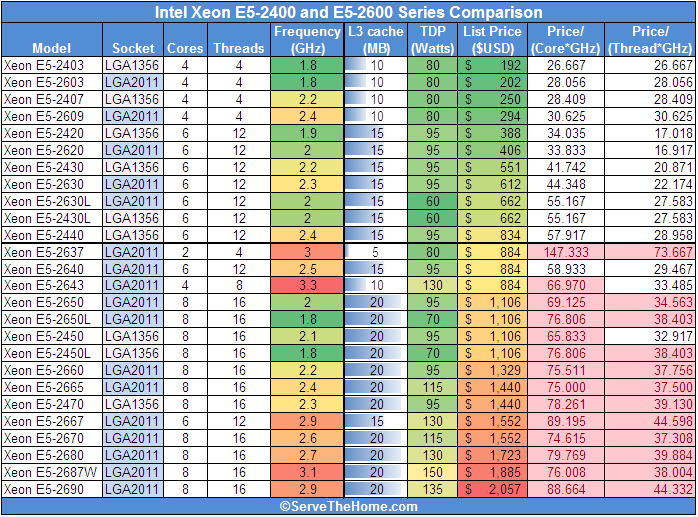Intel will be launching the Xeon E5 series in the near future. The Xeon E5-1600 series CPUs are single socket only with three parts that look like their Core i7 desktop counterparts and have either four our six cores plus Hyper Threading. The high-end will be taken by the Xeon E5-4600 series, with the ‘4’ denoting that the CPUs will be four socket capable. Probably the sweet spot for most readers on this site will be the Xeon E5-2400 and E5-2600 series. These CPUs will be both single and dual socket capable with the E5-2400 series having only one QPI link and three memory channels per LGA 1356 socket. The slightly higher-end here is the Xeon E5-2600 series which will utilize the LGA 2011 socket and therefore four memory channels per socket (one can see this in the X79 consumer platforms today.)
After taking a look at a LGA 2011 3.1GHz Xeon E5-2600 part from a benchmark and performance standpoint, and coming away impressed, I decided to put together a table that highlights the entire 2P capable Xeon E5-2400 and Xeon E5-2600 lines.

One can see a few things here. First Intel has created several points of parity between LGA1356 and LGA2011 Xeon E5 CPUs. Examples are the Xeon E5-2403 and E5-2603 where there is a $10 premium for the LGA 2011 platform. Others include the E5-2420 and E5-2620 with the E5-2620 gaining 100MHz, the LGA 2011 socket and a $18 price bump. The low power chips of the E5-2430L and the E5-2630L have the same specs and the same list price save the socket. Finally the E5-2470 and E5-2665 both hit the $1,440 price point with the LGA 2011 part posting a 100MHz bump for the same price. Overall, at these parity points, Intel does give one slightly more for the money on the LGA 2011 platform.
Another aspect I looked at was a simple calculation of Price/ (Cores * GHz) and Price/ (HT Cores * GHz). Of the two, I think that Price/ (Cores * GHz) is going to be more informative because applications tend to scale in performance with physical cores. If one were comparing the HT core number (possibly for a logical core/ Opteron 6200 series comparison), they should look at an application profile, and then assign an uplift for HT performance (if it exists in the application.) With that being said, I highlighted the below average Price/ (Cores * GHz) numbers above. One must remember that enterprise applications are often priced per socket or per server, and by having more processing power in a server, if one can consolidate more application onto the box, there is a cost avoidance of purchasing additional hardware and software. As a result, Intel is reflecting this in their pricing by charging a premium for extra performance, although the E5-2667 seems a bit off the curve.
I will say that I am a bit bummed that Intel has continued to handicap the sub-$300 CPU market. These CPUs are of little use to a consumer from a price/ performance standpoint, but I think Intel could have at minimum made them four core plus Hyper-Threading in this generation. The Xeon E5-2637 seems exceedingly overpriced for a 2C/4T/5MB part since it is basically a Core i3-2100 CPU performance wise.




You’ve got a typo in your title that had me confused for a bit…didn’t know what the E5-2500 series was, thought you were getting a scoop out. Oh well. Its still good info!
No big scoop, I do a lot of pricing consulting so always interesting to see pricing strategies. I saw the typo just after hitting publish and corrected a few seconds thereafter (but it may have gotten cached with the typo for a few minutes.) Thanks PL!
the E5-2637 is likely targeted at MS SQL or oracle deployments.
Intel/Oracle are starting to heard toward a per core licensing scheme on these products, and with the software being so costly, Intel flatly CAN charge this premium for these parts.
I think you have a typo somewhere in the table with respect to the 2670 2667 the 2667 is faster but the same price yet has a higher price/core*ghz.
Lyle, the Xeon E5-2667 is a higher clocked 130w, 6 core 12 thread 15MB part while the X5-2670 is a lower clocked 115w 8 core 16 thread 20MB part.
You should also look at performance per watt. performance could be Core*GHz*L3Cache to give an idea of how green the the particular chip is?
Great table, epecially the price/(core*freq)! Made choosing cpu a lot easier!
Great table – any chance of refreshing it since it’s now 15 months old?
Hi Gavin, will likely do a refresh with the V2 processors in Q3.
Got a refresh now that Grantley is released?
Aaron – I will likely do a refresh in the next week. I have been working a form 6:30AM to 2 or 3AM straight for the past month so a bit busy.